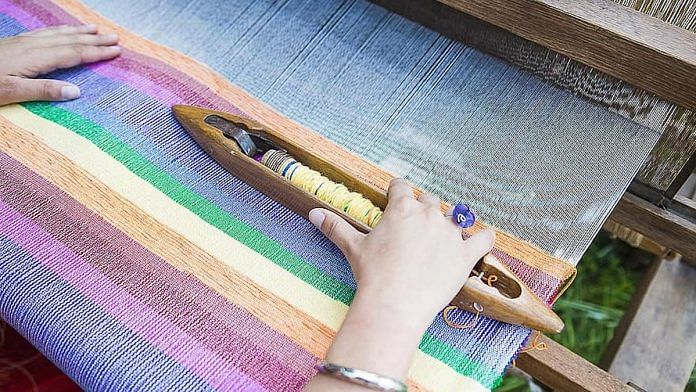The current coronavirus crisis has revealed the many pitfalls of globalisation and over-dependence of the world economy on a few manufacturing hubs. To address this, Prime Minister Narendra Modi announced the Aatmanirbhar Bharat, or self-reliant India, plan. If India wants to achieve economic sustainability, then it must cut imports significantly and fill the demand-supply gap with indigenous production — and go ‘vocal about local’. The genesis of this in the Swadeshi Movement that started in 1905, and was led later by none other than the messiah of khadi weavers, M.K. Gandhi.
And it’s khadi that we need to rely on again for a sustainable and aatmanirbhar economy.
A sustainable choice
Khadi is not only a source of sustenance for thousands of Indians — it’s a part of our social fabric. An economic measure cannot be called sustainable unless its benefits reach peasants and artisans. Nearly a century ago, Gandhi found the answer to rural India’s financial independence in khadi and promoted it until his death.
It ameliorated the socio-economic conditions of many villagers. Compatibility with the environment, which is a precondition for sustainable economic activity, can be easily noticed in the production of khadi. Manufacturing one metre of khadi requires just 3 litres of water against the 56 litres needed for mill fabric, according to V.K. Saxena, chairman of Khadi and Village Industries Commission. This also helps in solving one of the most pressing issues of today — the water crisis in both rural and urban India.
Also read: Yogi govt orders manufacturing of 66 crore triple-layer khadi masks amid Covid-19 outbreak
Fad factor
India is the second-largest exporter of textiles and clothing in the world and the sector got $22.94 billion from exports in FY20. And according to recent industry reports, the share of khadi in total textile mill production is about 8.49 per cent.
Also, being organic, sustainable, and skin-friendly in nature, khadi is becoming immensely popular across various sections of society, including the influential class. Consequently, the sale of khadi-made apparels and fabric has witnessed a 164 per cent growth in the last five years. From politicians to film stars, today, all powerful personalities want to spell their magic in business and social events with the sophistication and grace of khadi.
Roots to riches
A large number of Indians live in villages and depend a lot on agriculture for livelihood, but this sector alone cannot eradicate problems like poverty and unemployment in rural areas. That’s why Gandhi strategically promoted khadi and handloom to improve rural socio-economic conditions. His farsightedness proved viable, and a large number of people in rural India found jobs in these village industries. Out of 5,81,000 villages in 1997-98, these industries were active in about 2,50,000. Later, the Khadi and Village Industries Commission (KVIC) also launched khadi jeans and the Sarvodaya brand to become relevant in the contemporary fashion industry.
Also read: Make ‘swadeshi’ uniforms and food items a must in schools, RSS affiliate tells Modi govt
Advantage khadi
Cotton is the primary raw material of khadi textile and with 5.77 million metric tonne produced in 2019, India is the largest producer of cotton in the world. At the same time, more and more people globally are preferring eco-friendly and bio-degradable products over artificial and synthetic substitutes. So, khadi has tremendous potential in domestic as well as international markets, and can contribute a lot towards India’s dream of a sustainable economy.
Be it curbing unemployment rate, eradicating poverty, and saving water bodies from massive industrial waste, khadi is a powerful antidote to many challenges India faces. In contrast, textile mills, which are highly mechanised and capital intensive, not only cause large-scale unemployment but also damage the environment.
Also read: With Modi saying ‘self-reliance’ 17 times in speech, India seems set to turn protectionist
Road ahead
In light of the Gandhian philosophy, a self-sufficient village economy is at the root of a self-reliant nation. There are many areas where India occupies the leadership position and cotton farming is one of them. Moreover, the country has over half a million skilled weavers who are experts in spinning khadi, the fabric that has become the first choice among fashionistas and aesthetes all over the globe.
Fortunately, the opportunities are enormous, the only thing required is the conversion of these opportunities into concrete results with the help of focused approach, favourable policies, and healthy market competition.
The author is a kathak dancer, social activist and co-founder of Sparsh Ganga. Views are personal.



